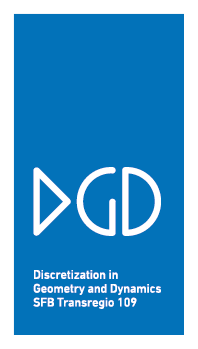The Discrete Plateau Problem
Felix KnöppelMedia
Description
Let $M$ be a discrete surface with boundary and let $V, E, F$ denote the set of vertices, (unoriented) edges and faces. Once we have a discrete metric, i.e. a map $\ell\colon E\rightarrow (0,\infty)$ such that the triangle inequalities hold for each face $\lbrace i,j,k\rbrace$, we can define the corresponding Dirichlet energy $E^\ell_D$ as $$E^\ell_D(f)=\sum_{ij\in\tilde E} \omega_{ij}^\ell(f_j-f_i)^2$$ where $$\omega_{ij}^\ell = \tfrac{1}{2}\left( \cot \alpha_{ij} + \cot \beta_{ij}\right)\,.$$ are the $\ell$-dependent cotangent weights. Here $\tilde E$ denotes the set of positively oriented edges.
Each map $f\colon M\rightarrow \mathbb{R}^3$ which maps the combinatoric triangles to non.degenerate triangles in $\mathbb{R}^3$ yields a discrete metric induced by $\mathbb{R}^3$.
A surface is known to be minimal, i.e. a critical point of the area functional under all variations fixing the boundary, if and only if it solves the Dirichlet problem (with respect to its induced metric). That is:
For each interior vertex $i\in V^\circ$ we have $$-\tfrac{1}{2}\sum_{ij \in E} \omega_{ij}^\ell f_i + \tfrac{1}{2}\sum_{ij\in E}\omega_{ij}^\ell f_j = 0\,.$$ Here $\ell$ is the metric that is induced by $f$.
Unfortunately, unlike the Dirichlet problem, this is a non-linear problem—the cotangent weights depend on $\ell$ in a complicated way. Though, fortunately, we can solve it in many cases by iteratively solving a Dirichlet problem. For details see [1]. Dirichlet problems can be solved more easily and the outcome of an implementation of this procedure is displayed here.
References
-
Ulrich Pinkall and Konrad Polthier.
Computing discrete minimal surfaces and their conjugates.
Experiment. Math.,, 1993.
dgd:496.










